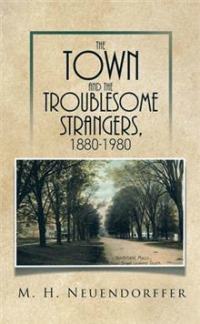Title: The Town and the Troublesome Strangers, 1880-1980
Author: M.H. Neuendorffer
Publisher: XlibrisUS
ISBN: 9781514413234
Pages: 400
Genre: Fiction/Historical/General
Reviewed by: Carol Davala
Buy on Amazon
Pacific Book Review
Mary Helen Neuendorffer had long held the desire to write about the small New England town which was such a major part of her ancestry. Beginning in the1880’s and spanning over a century with six generations of her family, they all have traveled to Northfield, MA. The area, graced with natural beauty and wrapped in a rich historical past, had touched the lives of many of this hearty, steadfast, and hardworking family with both permanent and temporary ties to the area. Keeping in mind this love and familiarity of New England, author M. H. Neuendorffer weaves an epic tale that followed a multitude of cross-generational characters and events that played out for readers in “The Town and the Troublesome Strangers, 1880-1980.” Like a well-designed tapestry, the author crafted a multi-faceted, flowing, and intricate story, a definite piece of art work.
Early on in the novel, readers are introduced to several of the fixture Northfield characters. These are the characters of the permanent residents who lived and worked the land of this northern area, but often felt invaded by the influx of seasonal visitors. There is a well incorporated devotional component to this storyline, marked by the likes of a scarred pastor who spoke about temperance, long-standing churches, and a large congregational population that flocked to the area renowned for its religious conferences.
M. H. Neuendorffer does an admirable job of containing an expansive scenario and timeline. Chapter headings help readers follow the characters in their ventures beyond the Northfield region. Whether in the youthful experiences of networking and enjoying NYC nightlife, high society failings in Washington, European bike tour treks, or wartime deployment to the South Pacific, life’s winding paths often delivers these seekers back to this hometown community. Midway through this tome, Neuendorffer smartly makes use of reflective conversations that connect past and present situations. One such nostalgic motorcycle ride allows two grown friends to reminisce about their long past adolescent escapades in town. For readers who might get confused by the sheer volume and overlapping connection of players, a helpful index is included whereby offering a substantial reference for organizing the names, dates, and places of major events that shape this monumental narrative.
While much of this story speaks to the stoic tenacity of those who settled in this New England area, at its heart this is a book about family, friends, and community. In the span of a century, a gamut of happenings and emotions unfolded. Here the broad sweep renders new births and death, joyous moments and painful sorrow. Readers will witness happy marriages and consequential divorce. Even small town America features teen angst and generational conflict, while on a grander scale readers will grasp the major impacts that crime, war, and politics have on a tight-knit community.
Much of this novel is revealed as a tale of history and contrast. Neuendorffer skillfully moves the setting between a countryside of rolling hills and the hustle and bustle of a cityscape. The staunch New Englanders who have made a lifetime commitment to the area, are at odds with the newcomers who arouse suspicion and conflict with their presence. The focus on an International Dinner at Manhattan’s Eastside Settlement, with its exotic foods, costumes, and foreign languages, along with Northfield’s establishment of “The First American Youth Hostel” exemplifies the draw for immigrants and foreign travelers into the melting pot arena of the U.S. From ambushed horse drawn carriages, President Wilson’s WWI directives, and the social mores of the early 20th century — to modern taxis, Vietnam protesters, and the flower power sexual revolution, this author clearly takes us on a whirlwind ride.
While Neuendorffer may lace this original work with the small town flavors of gossiping ladies, young lovers, or menfolk who sneak off for a swig of rum, such elements are merely pieces of a larger picture. Ultimately in an ever-evolving world, even the solid fictional inhabitants of Northfield come to realize the powerful messages that resonates from the core of this tireless, far-reaching novel. Like the resounding refrain of the popular ’60s societal anthem surely reveals, “The Times They Are a-Changin’.”


